We support improving sustainable cooking practices
 One half of the world cooks on open fires. In rural areas, everyone does. Smoke from cooking fires kills more people worldwide than AIDS, tuberculosis and malaria combined. And that smoke is a leading cause of blindness.
One half of the world cooks on open fires. In rural areas, everyone does. Smoke from cooking fires kills more people worldwide than AIDS, tuberculosis and malaria combined. And that smoke is a leading cause of blindness.
In the rural communities in Northern Uganda, Aid Africa is changing not only the way they cook, but also the broader food preparation infrastructure. The changes in these communities over the past ten years has provided, and continues to provide local people valuable knowledge to improve their cooking efficiencies and reduce environmental impacts beyond local villages.
Smoke from open fires leads to constant eye irritation, scarring and blindness. Particulates in smoke and other emissions irritate the lungs causing respiratory diseases. The danger of burns is real and thatched roof houses frequently catch fire. Additionally, cutting trees for open fire leads to deforestation, so women and children to walk farther to get firewood for cooking. The removal of trees without sufficient reforestation contributes to habitat damage, biodiversity loss, and aridity.
In collaboration with local communities over the past ten years, Aid Africa’s engineers have designed, tested, and re-designed the Rocket Stove.

The current design uses just a third of the fuel for cooking than an open fire, and produces about 75% less emissions. Deceptively simple and based on the best scientific principles, it is designed to be very inexpensive, easy to mass produce with local materials, and intended to help the most people.
As of November 2019, the stove has been tested as installed in homes and qualifies for carbon credits. CREEC, the testing facility in Uganda, certifies our stove is the most efficient wood burning stove tested in Uganda. more than 4,500 stoves have been certified by the U.N. for their efficiency and are actively maintained for maximum efficiency. All of our donors can be proud of the work we’ve done in of all our communities.

Our Six Brick Rocket Stoves:
- Use just a third of the wood of traditional fires
- Emit about a quarter of the particulate matter (less smoke)
- Need about half the time collecting firewood – it’s safer for the women and children
- Decreases diseases caused by smoke and poison gasses
- Reduces the risk of burns – especially to young children who may fall into a fire
- Reduces the risk of fire, possibly igniting a grass thatch roof that can spread
- Take half the time to cook
- Are easier to use
- Women have more time for other activities – That’s reduced poverty!
The Rocket Stove is made from six bricks crafted in Gulu from local materials. These bricks are very lightweight and will float on water. Their purpose is to act as insulation and keep the fire very hot so the fuel will burn up completely. Smoke is unburned fuel. An efficient fire has very little smoke.

Aid Africa staff work with local villages to bring Rocket Stove build workshops to their community. There is currently a queue of communities seeking new stoves. Community members are given materials and training to build and install their own stoves. But Aid Africa’s service work doesn’t end with the workshop, it is only one part of our infrastructure of building relationships.

Annually. Aid Africa staff with Gulu University volunteers, visit every stove in every village to maintain the stoves in “as new” condition.
Additionally, the Rocket Stove’s impact is expanding beyond individual home cooking. Requests by institutions for larger scale cook stoves have prompted consideration for a next phase of Research and Development. NGOs serving other communities have requested expansion of our manufacturing of bricks.
Lakeri’s Story (from the April 2019 newsletter)
My name is Lakeri Adoch, 80 years old and a resident of Lyo Boo village. I have four grandchildren and eight dependents. I have been using this Rocket Stove for six months now. I got excited when I heard about Aid Africa’s stove being brought to my village. Unfortunately I delayed and arrive at the distribution late, so I missed it. This happened on two occasions and after three weeks the community leader reminded me of the next distribution in the neighboring village three kilometers from my home so I left home early and managed to get one. From the teaching and demonstration, I saw how to make a fire and how to mud the stove. It looks beautiful and I admire and love the stove. It cooks well with less smoke and uses less firewood. It is convenient for old people like me. Initially my worry was the new stove would not keep the fire for long but to my surprise it is twice as good as the three stone open fire. Within six months this change, especially cooking time has greatly improved. My little grandchildren help gather small pieces of firewood because I am physically weak and unable to gather and split big sized wood.

 Follow
Follow